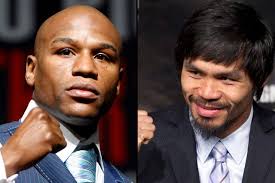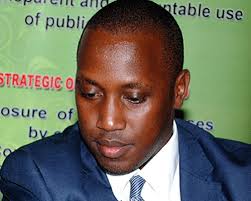What’s next for Floyd Mayweather Jr. and Manny Pacquiao?
By Augustine A.
What’s next for Mayweather? After improving to 48-0 with his unanimous-decision triumph Saturday at MGM Grand (judges scored it 118-110, 116-112, 116-112), Mayweather said he plans to fight just once more, in September on Showtime pay-per-view, and then call it a career.

His most likely opponent left the arena beaming. All Amir Khan has to do is beat Chris Algieri later this month. Algieri was knocked down six times by Pacquiao in November in Macao.
Mayweather will be a prohibitive favorite over Khan. He can retire in peace, but he also may feel the tug of opening a new massive arena in Las Vegas in 2016, and pursuing a 50-0 record that would top former heavyweight champion Rocky Marciano’s 49-0 record at retirement.
Mayweather, if you didn’t know, likes to call himself the Best Ever.
2. What’s next for Pacquiao? Likely surgery. His right shoulder, injured in sparring, was re-aggravated in the fourth round, and Pacquiao said he looked in the remaining rounds to find a left-handed knockout punch that he never delivered.
His shoulder injury, to be examined Monday, and then later after he returns to the Philippines, is said to be similar to Kobe Bryant’s.
If he undergoes surgery, he could be out three to eight months, depending on his recovery, and it wouldn’t be surprising to see him move back down to 140 pounds, where he could knock opponents out. He hasn’t done so since 2009.
lRelated Letting Pacquiao fight Mayweather injured dealt damaging blow to boxing’s future
SPORTS
Letting Pacquiao fight Mayweather injured dealt damaging blow to boxing’s future
3. Will there be a rematch? Once they count up all the dollars made by this fight, greed will certainly again enter the equation and that arena-opening date could be it.
Deservedly so, there will be some distaste from consumers following Saturday’s bout, soiled by Pacquiao’s injury talk and Mayweather’s technical performance.
Asked if the outcome left the rematch idea dead, Pacquiao promoter Bob Arum told The Times early Sunday morning, “Don’t say dead.”
4. What’s the next big fight we can look forward to? It’s not scheduled yet, and both guys have fights to win, but a possible late-fall showdown between Mexico’s Saul “Canelo” Alvarez and Puerto Rico’s Miguel Cotto would revive that always popular rivalry.
Floyd Mayweather Jr. is right on the money in beating Manny Pacquiao
Floyd Mayweather Jr. is right on the money in beating Manny Pacquiao
Cotto, who fights Daniel Geale in June, might also get talked into fighting unbeaten knockout king Gennady Golovkin, who fights at the Forum on May 16.
So whoever he picks is the big one.
5. Did Pacquiao’s injury really make a difference? Did the shoulder pain cost him a victory? No. He lost the first three rounds before he said he felt the pain in his dominant fourth.
Pacquiao clearly had problems finding Mayweather and that had nothing to do with his shoulder. Mayweather landed some crisp rights and jabs that kept Pacquiao at bay, as well.
But if he could’ve used his right hook at all, maybe we would’ve seen more rounds like the fourth – more of the type of action that convinced so many to pay $99.95 for the pay-per-view.
6. Is Mayweather the greatest non-heavyweight ever? His resume is impressive, and has him in the same conversation with Sugar Ray Robinson.
Certainly, boxing purists will say Robinson, despite losses on his record, is the greatest. He fought steadily, took on his greatest adversaries repeatedly and was blessed with all of boxing’s most appealing skills.
In this era, Mayweather said he came to realize he couldn’t fight everyone who challenged him throughout a year. He’s waited too long to take on opponents after stepping up to beat Oscar De La Hoya in 2007 – including Pacquiao – but he has now beaten every fighter the experts have said he should take on and deserves deep respect for his work inside the ring.
7. Who will assume the “best” mantle when Mayweather quits? Golovkin is a candidate with his lofty knockout percentage, but he’s 32.
Mayweather defeats Pacquiao by unanimous decision
Mayweather defeats Pacquiao by unanimous decision
Among the younger breed, both of the undercard winners, featherweight world champion Vasyl Lomachenko, and super-bantamweight world champion Leo Santa Cruz, have the potential to reach lofty heights.
If Lomachenko fights Nicholas Walters next, that’s a can’t-miss, and Santa Cruz has to stop being protected right now by his manager Al Haymon and fight Abner Mares and everyone else talented around his weight to let his supreme body-punching skills shine.
8. Will fans have a bad taste after shelling out $100 for a bad fight? Yes, continuing boxing’s reputation for getting everyone’s attention and then letting everyone down.
If Pacquiao was seriously hurt, postpone the fight until he’s healthy. The payments were made on the basis that both men would be 100%. That wasn’t the case.
One fight insider who declined to be identified because of his position said, “Too many people were in too big of a hurry to get paid.”
They could’ve still been paid and staged a bout that might’ve been more competitive, without this cloud over a fight that we waited five-plus years for, yet feels like it was unnecessarily rushed in the end.
Beyond that, nationwide satellite/cable problems or not, it looked stomach-turning to delay the fight’s start by forcing fans to wait as the maximum number of pay-per-view orders could roll in.
Ironically, Magic Johnson was interviewed about the bout during the delay. He knows a thing or two about sticking it to the fans in favor of television revenue.

And, in the end, that’s how Saturday’s events made it feel: The fans don’t matter, money does.




















